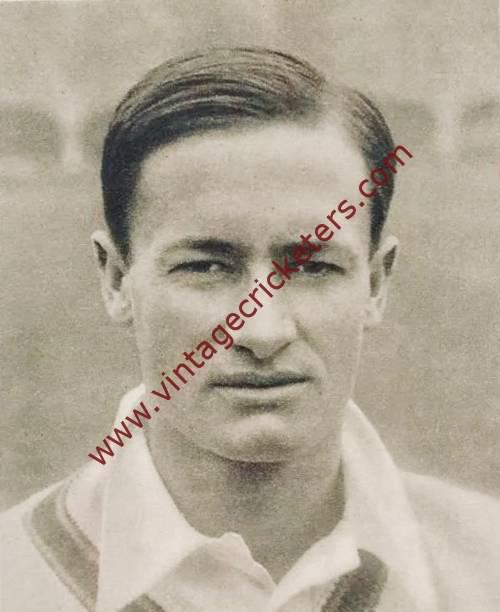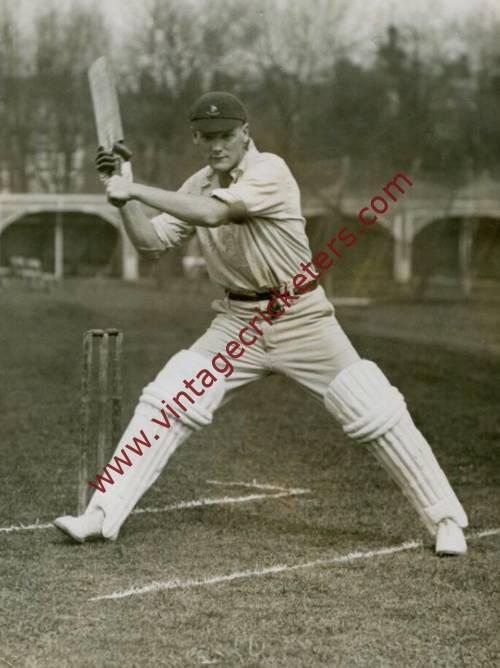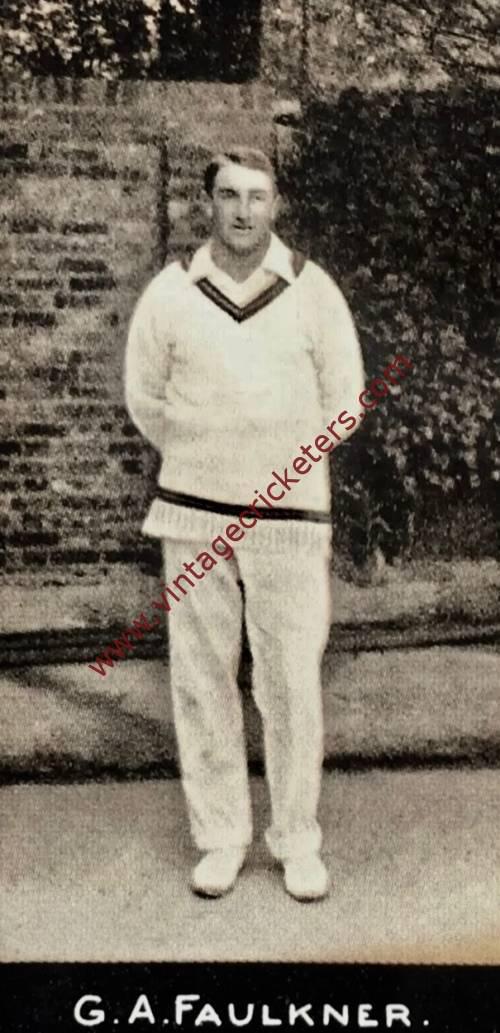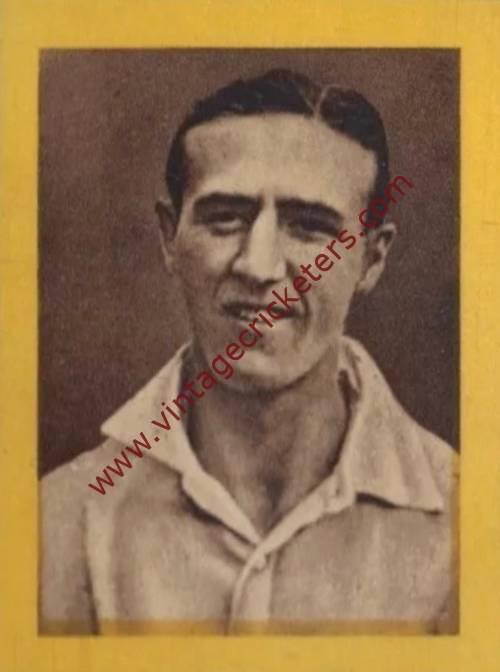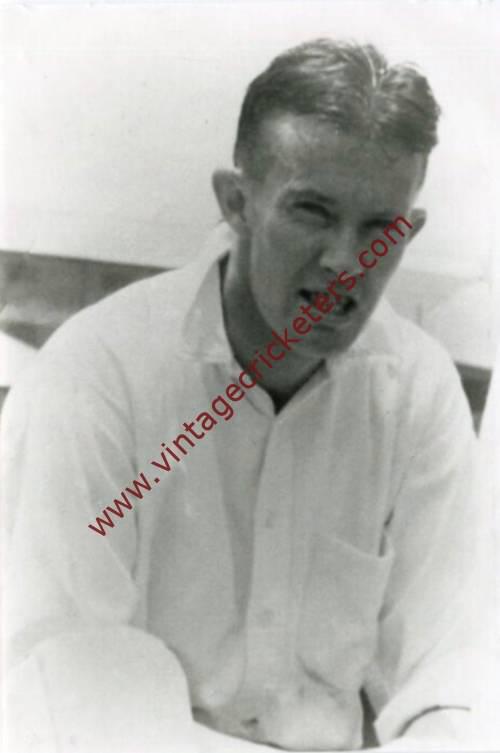Please choose your photo size from the drop down menu below.
If you wish your photo to be framed please select Yes.
Note: 16″x 20″not available in a frame.
Images can also be added to accessories. To order please follow these links
£8.95 – £49.95
Please choose your photo size from the drop down menu below.
If you wish your photo to be framed please select Yes.
Note: 16″x 20″not available in a frame.
Images can also be added to accessories. To order please follow these links
The maximum number of views of this element is reached.
Please contact the webmaster to enable unlimited views.
Kimberley, Cape Province born right-arm fast bowler George Bissett was considered the fastest bowler in South Africa in the 1920’s, and as a right-handed lower-order batsman he could hit hard, as well as being a fine fieldsman. He had a spasmodic first class cricket career extending over eight years and taking in three domestic South African teams plus a tour to England, but amounting to only 21 first class matches in all.
Bissett made his first class debut in two matches for Griqualand West against Orange Free State in 1922-23 and in the second of them he took 5-38 in their first innings from 10 overs. The following year he improved on those figures by taking 6-87 in Border’s first innings. That led to his selection for the 1924 South African tour to England, still aged only 19. The tour was not a success for Bissett. Played very sparingly in the early matches, he had run into some form by the end of June and took five second innings Hampshire wickets for 102 runs. But less than two weeks later he injured his foot bowling against Yorkshire and was unable to play again having played just seven matches.
Bissett then disappeared from first class cricket for three and a half years until he was a surprise selection for the Second Test in the 1927-28 home series against England, making his Test debut at Cape Town on the final day of 1927. England had won the First Test easily by 10 wickets; Bissett, who was playing second division league matches in Cape Town, was brought in to strengthen the bowling and was immediately successful, taking the first five wickets to fall and finished with 5-37. There were three further wickets in the second innings, though they came at greater cost.
The Times report of the first day of the match detailed the circumstances of Bissett’s surprise selection: “Bissett was selected on the frail qualification of having taken seven wickets for 28 runs in a senior club match last week, this being the only glimpse of form which he has shown since he was selected to tour England with Taylor’s team in 1924, when he proved to be a dismal failure.” Despite Bissett’s success, England still won the match, albeit by a narrower margin than the previous game.
The balance of power in the Test series was shifting and the next match was drawn, though Bissett failed to take any wickets. It shifted even further in the fourth Test at Johannesburg and South Africa won by four wickets. Bissett was partnered with the left-arm fast-medium bowler Alf Hall and they took all 10 wickets between then in England’s first innings, with Bissett returning 4-43 and Hall 6-100. In the second innings, Bissett took four more wickets (for 70 runs) and Hall took three.
The South African recovery was completed with a victory by eight wickets in the final Test of the series to level the rubber at two victories each, and again Bissett played a big part. He took two wickets in England’s first innings when Buster Nupen was the main bowler, with 5-83. But in England’s second innings, Bissett produced the best bowling of the series and of his career, taking 7-29. The Times reported that Bissett, aided by a “stiff westerly wind”, made the ball rise awkwardly and “demoralized the English batsmen with some great fast bowling”. It went on: “At the end of the innings Bissett was carried shoulder-high by the crowd to the pavilion… It was officially announced that the ball with which Bissett accomplished his feat of taking seven English wickets for 29 runs would be suitably mounted and presented to him by the South African Cricket Association.”
Bissett was one of four players – the others were Nupen, Bob Catterall, and Ernest Tyldesley – who were invited to plant a tree on the boundary at the Kingsmead cricket ground after the match. The rest of Bissett’s career as a cricketer was anticlimax. Before the English team left South Africa, Bissett played a single first class match for Western Province against them, and failed to take any wickets.
Bissett was unable “to make the trip” when South Africa toured England in 1929. He in fact played in only one further first class match, a solitary appearance for Transvaal in the 1929-30 season in which he took two wickets in the first Natal innings, but did not bowl at all in the 97.3 overs of the second innings. The following year, he played in a non-first class match for a Northern Rhodesia side against the 1930-31 England touring team, taking two wickets.
In 21 first class matches, Bissett averaged 15.47 with a highest score of 33, also making 23 in his last Test innings in the match at Johannesburg, finishing with a Test average of 19 due to not outs. His bowling produced 67 wickets, 25 of those in Tests, at 27.10 apiece, five times taking five wickets or more in an innings.
Vintage Cricketers was founded in July 2019. There may be more photographs of this cricketer in the Vintage Cricketers library, which are due to be loaded in due course. In the meantime, please send a message to us using the contact form at the bottom left of this page and we can arrange to prepare and publish all images of this cricketer if you have a particular interest in him.
| Weight | N/A |
|---|
